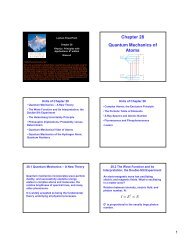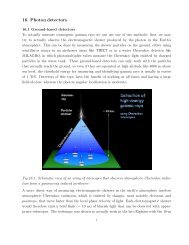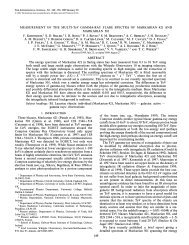Gamma-Rays Produced in Cosmic-Ray Interactions and TeV-band ...
Gamma-Rays Produced in Cosmic-Ray Interactions and TeV-band ...
Gamma-Rays Produced in Cosmic-Ray Interactions and TeV-band ...
You also want an ePaper? Increase the reach of your titles
YUMPU automatically turns print PDFs into web optimized ePapers that Google loves.
threshold up to a few GeV [8].<br />
In addition to the theoretical approach, the parametrization of the <strong>in</strong>clusive cross section<br />
of π 0 production <strong>in</strong> pp collisions based on the accelerator data was also studied [10, 21, 24].<br />
The validity of a parametrization depends on the functional formulae chosen <strong>and</strong> also the<br />
data used to determ<strong>in</strong>e the free parameters. Thus, the parametrization method often reproduces<br />
tails extend<strong>in</strong>g beyond the energy-momentum conservation limit, which might<br />
result <strong>in</strong> unphysical structures when the spectrum is calculated <strong>in</strong> a broad energy range. It<br />
is recognized [20, 22] that these parametrizations lose accuracy <strong>in</strong> the high energy regime<br />
<strong>and</strong> come with a k<strong>in</strong>ematic limit of validity. The parametrization of Stephens <strong>and</strong> Badhwar<br />
[10] under-predicts the yield of high energy pions. The work of Blattnig et al. [21] is valid<br />
only for energies E p below 50 GeV, <strong>and</strong> above this energy it extremely over-predicts the<br />
pion production <strong>and</strong> carries a k<strong>in</strong>ematic <strong>in</strong>validity; Kamae et al. [24] have exercised much<br />
care <strong>in</strong> determ<strong>in</strong><strong>in</strong>g the <strong>in</strong>clusive cross section near the pion production threshold, but the<br />
same problems with k<strong>in</strong>ematic <strong>in</strong>validities, etc, arise <strong>in</strong> the high energy range.<br />
The spectral distribution of secondary particles <strong>and</strong> the total cross section are not directly<br />
obta<strong>in</strong>able due to the lack of data. Nevertheless, one can calculate the energy spectrum<br />
or total <strong>in</strong>clusive cross section by <strong>in</strong>tegrat<strong>in</strong>g the parameterized differential <strong>in</strong>clusive cross<br />
section over the whole phase space (the scatter<strong>in</strong>g angle <strong>and</strong> the energy). By analyz<strong>in</strong>g the<br />
behavior of the <strong>in</strong>tegral, it is possible to evaluate the accuracy <strong>and</strong> validity limit of different<br />
parametrizations. For example, by the analysis of the total cross section, a parametrization<br />
which cannot <strong>in</strong>tegrate to a correct total cross section can be ruled out, even though the<br />
<strong>in</strong>variant differential cross section data can be reproduced, s<strong>in</strong>ce the global behavior of<br />
the parametrization is not accurate. On the other h<strong>and</strong>, produc<strong>in</strong>g a correct total cross<br />
section upon <strong>in</strong>tegration doesn’t necessarily imply accuracy of the global behavior of this<br />
parametrization. This disadvantage results from the fact that the available data are not<br />
sufficiently constra<strong>in</strong><strong>in</strong>g the parametrization of differential cross sections.<br />
B. <strong>Cosmic</strong>-ray generated hadronic <strong>in</strong>teractions by Monte Carlo event generator<br />
DPMJET-III<br />
In particle physics, the Monte Carlo simulation approach is widely applied to obta<strong>in</strong><br />
<strong>in</strong>formation on particle production <strong>in</strong> hadronic <strong>in</strong>teractions.<br />
The pr<strong>in</strong>ciple advantage of<br />
5







